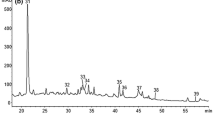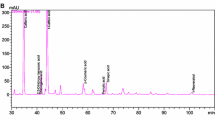Abstract
The aim of this study was to assess the influence of different winemaking technologies on the chemical characteristics and, in particular, on the phenolic fraction of Aglianico, Montepulciano, Nero di Troia and Sangiovese wines produced in Apulia, Southern Italy. Four different winemaking technologies were compared: control (traditional, 5 days of maceration at 25 °C with three daily punching-down), prolonged maceration (10 days), addition of ellagic tannins and cryomaceration (24 h at 5 °C using dry ice), without any other oenological treatment. Results showed that the different technologies slightly influenced the phenolic fraction of Aglianico, which is known to be naturally rich of phenols. On the contrary, the prolonged maceration led to an increase of total phenols (TP) in Nero di Troia (2,592 mg/kg vs. 2,115 mg/kg of control) and a decrease in Sangiovese (869 mg/kg vs. 1,013 mg/kg); the addition of tannins led to an increase of TP in Montepulciano (1,358 mg/kg vs. 1,216 mg/kg) and to a decrease in Sangiovese (916 mg/kg vs. 1,013 mg/kg); and cryomaceration led to a decrease of anthocyanins in all cultivars (about 15%). Phenols extraction from grapes was found to be mostly dependent on the grape variety rather than on the applied winemaking technology.


Similar content being viewed by others
References
Jackson RS (1994) Wine science: principles and applications. Academic Press, New York
Ribéreau-Gayon P, Glories Y, Maujean A, Dubourdieu D (2006) Handbook of enology, vol 2. The chemistry of wine stabilization and treatments, 2nd edn. Wiley, Chichester
Kosir IJ, Lapornik B, Andrensek S, Wondra AG, Vrhovsek U, Kidri J (2004) Identification of anthocyanins in wines by liquid chromatography, liquid chromatography-mass spectrometry and nuclear magnetic resonance. Anal Chim Acta 513:277–282
Fresco P, Borges F, Diniz C, Marques MP (2006) New insights on the anticancer properties of dietary polyphenols. Med Res Rev 26:747–766
Soleas GJ, Grass L, Josephy PD, Goldberg DM, Diamandis EP (2006) A comparison of the anticarcinogenic properties of four red wine polyphenols. Clin Biochem 39:492–497
Pérez-Lamela C, García-Falcón MS, Simal-Gándara J, Orriols-Fernández I (2007) Influence of grape variety, vine system and enological treatments on the colour stability of young red wines. Food Chem 101:601–606
González-Neves G, Gil G, Barreiro L (2008) Influence of grape variety on the extraction of anthocyanins during the fermentations on skins. Eur Food Res Technol 226:1349–1355
Gómez-Plaza E, Gil-Munõz R, López-Andreu FJ, Martínez A, Fernández-Fernández JI (2001) Phenolic compounds and color stability of red wines: Effect of skin maceration time. Am J Enol Vitic 52:266–270
Harbertson JF, Mireles MS, Harwood ED, Weller KM, Ross CF (2009) Chemical and sensory effects of saignée, water addition, and extended maceration on high brix must. Am J Enol Vitic 60:450–460
Koyama K, Goto-Yamamoto N, Hashizume K (2007) Extraction of phenolics from berry skins and seeds of grape (Vitis vinifera) during red wine maceration and influence of temperature profile. Biosci Biotechnol Biochem 71:958–965
Peinado RA, Moreno J, Bueno JE, Moreno JA, Mauricio JC (2004) Comparative study of aromatic compounds in two young white wines subjected to pre-fermentative cryomaceration. Food Chem 84:585–590
Esti M, Tamborra P (2006) Influence of winemaking techniques on aroma precursors. Anal Chim Acta 563:173–179
Parenti A, Spugnoli P, Calamai L, Ferrari S (2004) Effects of cold maceration on red wine quality from Tuscan Sangiovese grape. Eur Food Res Technol 218:360–366
Álvarez I, Aleixandre JL, García MJ, Lizama V (2006) Impact of prefermentative maceration on the phenolic and volatile compounds in Monastrell red wines. Anal Chim Acta 563:109–115
Gil-Munõz R, Moreno-Pérez A, Vila-López R, Fernández-Fernández JI, Martínez-Cutillas A, Gómez-Plaza E (2009) Influence of low temperature prefermentative techniques on chromatic and phenolic characteristics of Syrah and Cabernet Sauvignon wines. Eur Food Res Technol 228:777–788
Heredia FJ, Escudero-Gilete ML, Hernanz D, Gordillo B, Meléndez-Martínez AJ, Vicario IM, González-Miret ML (2010) Influence of the refrigeration technique on the colour and phenolic composition of Syrah red wines obtained by pre-fermentative cold maceration. Food Chem 118:377–383
Baiano A, Terracone C, Gambacorta G, La Notte E (2009) Phenolic content and antioxidant activity of Primitivo wine: comparison among winemaking technologies. J Food Sci 74:C258–C267
Neves AC, Spranger MI, Zhao Y, Leandro MC, Sun B (2010) Effect of addition of commercial seed tannins on phenolic composition, chromatic characteristics, and antioxidant activity of red wine. J Agric Chem 58:11775–11782
Di Stefano R, Cravero MC (2001) Methods for grape phenolic compound study. Riv Vitic Enol 2:37–45
EEC (1990) European communities. Commission regulation No 2676/90 on “Community analysis methods to use in wine sector”. Off J Eur Commun No. L272/3.10.90
Revilla E, Ryan LM (2000) Analysis of several phenolic compounds with potential antioxidant properties in grape extracts and wines by high-performance liquid chromatography-photodiode array detection without sample preparation. J Chromatogr A 881:461–469
Revilla E, Garcia-beneytez E, Cabello F, Martin-Ortega G, Ryan JM (2001) Value of high performance liquid chromatographic analysis of anthocyanins in the differentiation of red grape cultivars and red wines made from them. J Chromatogr A 915:53–60
González-Neves G, Charamelo D, Balado J, Barreiro L, Bochicchio R, Gatto G, Gil G, Tessore A, Carbonneau A, Moutounet M (2004) Phenolic potential of Tannat, Cabernet-Sauvignon and Merlot grapes and their correspondence with wine composition. Anal Chim Acta 513:191–196
Lovino R, Baiano A, Pati S, Faccia M, Gambacorta G (2006) Phenolic composition of red grapes grown in Southern Italy. Ital J Food Sci 18:177–186
Tamborra P, Esti M (2010) Authenticity markers in Aglianico, Uva di Troia, Negramaro and Primitivo grapes. Anal Chim Acta 660:221–226
Mattivi F, Guzzon R, Vrhovsek U, Stefanini M, Velasco R (2006) Metabolite profiling of grape: flavonols and anthocyanins. J Agric Food Chem 54:7692–7702
La Notte E, Antonacci D, la Gatta M, Pati S, Coletta A, Gambacorta G (2008) Influence of irrigation and grape production on the phenolic and volatile fraction of black wine grape Sangiovese. Proceeding XXXIth OIV World Congress, Verona
Lovino R (1987) Survey on the chemical composition of the V.Q.P.R.D. wines mostly produced with “Uva di Troia”. Riv Vitic Enol 40:3–23
Moio L, Romano S, Cirella A, Fuschino G (1999) Influenza di alcuni fattori viticoli ed enologici sulla qualità del vino rosso prodotto dall’uva “Aglianico” di Taurasi. Vignevini 1–2:79–92
Sims C, Bates R (1994) Effects of skin fermentation time on the phenols, anthocyanins, ellagic acid sediment, and sensory characteristics of a red Vitis rotundifolia wine. Am J Enol Vitic 45:56–62
Gao L, Girard B, Mazza G, Reynolds AG (1997) Changes in anthocyanins and color characteristics of Pinot noir wines during different vinification processes. J Agric Food Chem 45:2003–2008
Gómez-Míguel M, Heredia F (2004) Effect of the maceration technique on the relationships between anthocyanin composition and objective color of Syrah wines. J Agric Food Chem 52:5117–5123
Morata A, Gómez-Cordovés MC, Suberviola J, Bartolomé B, Colombo B, Suárez J (2003) Adsorption of anthocyanins by yeast cell walls during the fermentation of red wines. J Agric Food Chem 51:4084–4088
García-Beneytez E, Revilla E, Cabello F (2002) Anthocyanin pattern of several red grape cultivars and wines made from them. Eur Food Res Technol 215:32–37
Kelebek H, Canbas A, Selli S, Saucier C, Jourdes M, Glories Y (2006) Influence of different maceration times on the anthocyanin composition of wines made from Vitis vinifera L. cvs. Bogazkere and Öküzgözü. J Food Eng 77:1012–1017
Reynolds A, Cliff M, Girard B, Kopp TG (2001) Influence of fermentation temperature on composition and sensory properties of Semillon and Shiraz wines. Am J Enol Vitic 52:235–240
Acknowledgments
This work was financially supported by Ministero dell’Economia e delle Finanze, Ministero dell’Istruzione, dell’Università e della Ricerca Scientifica e Tecnologica e l’Assessorato Bilancio e Programmazione Regione Puglia by the program ‘‘Accordo di Programma Quadro in Materia di Ricerca Scientifica della Regione Puglia—Progetto Strategico—Title: ‘Improvement and valorisation of variety expression of Apulian oenological production”’.
Author information
Authors and Affiliations
Corresponding author
Rights and permissions
About this article
Cite this article
Gambacorta, G., Antonacci, D., Pati, S. et al. Influence of winemaking technologies on phenolic composition of Italian red wines. Eur Food Res Technol 233, 1057–1066 (2011). https://doi.org/10.1007/s00217-011-1613-7
Received:
Revised:
Accepted:
Published:
Issue Date:
DOI: https://doi.org/10.1007/s00217-011-1613-7




